|
|
|
Sort Order |
|
|
|
Items / Page
|
|
|
|
|
|
|
| Srl | Item |
| 1 |
ID:
121408
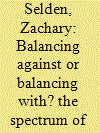

|
|
|
|
|
| Publication |
2013.
|
| Summary/Abstract |
During the 2001-2009 period when American foreign policy was internationally unpopular and perceived as unilateral, many states strengthened their security cooperation with the United States and facilitated the reach of the us military. This behavior spans a range of actions along a spectrum from reaffirming traditional alliances to far more subtle forms of alignment. This pattern is in large part driven by the actions of regional powers such as Russia and China whose rising power pushes neighboring states to seek the assurance of the United States, and it has distinct implications for the endurance of American hegemony. As those regional powers seek to expand their influence, secondary states may increase their contributions to the maintenance of American hegemony, thus helping to extend it well into the future. They are less prone to do so, however, if the United States follows a strategy of restraint that calls into question its willingness to defend its hegemony. Therefore, a policy focused on maintaining American military preeminence and the demonstrated willingness to use it may be what sustains the cooperation from second-tier states that helps to maintain American hegemony.
|
|
|
|
|
|
|
|
|
|
|
|
|
|
|
|
| 2 |
ID:
121403
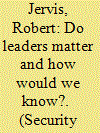

|
|
|
|
|
| Publication |
2013.
|
| Summary/Abstract |
This paper will explore the ambivalence or conflict in the literature about the extent to which leaders matter in international politics, commonly linked to the level-of-analysis question. One the one hand, national leaders are often larger than life figures with strong preferences and distinctive personalities who seem to leave their stamp on events. On the other hand, most ir scholars place great stress on the incentives and constraints posed by the environment, be it domestic or international. I will proceed in four sections. The first discusses the essential claims at stake, the kinds of evidence that could be adduced to support one position or the other, and the pathways by which individual differences can make themselves felt. The second section examines the implications for morality, responsibility, and democratic theory. This discussion too will point to relevant methods, including ones that are contested. I will then turn to post-Cold War American foreign policy, skeptically examine the claim that individual presidents, even George W. Bush, mattered as much as is generally believed and close by discussing the implications for democratic accountability and control.
|
|
|
|
|
|
|
|
|
|
|
|
|
|
|
|
| 3 |
ID:
121405
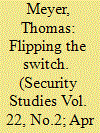

|
|
|
|
|
| Publication |
2013.
|
| Summary/Abstract |
Contemporary us counterinsurgency doctrine in Iraq and Afghanistan requires junior leaders to engage in both combat and state-building activities. This study aims to explain the fundamental challenge in merging these. I argue that difficulty lies in separating insurgents from civilians, and translating doctrine from senior to junior officers. Junior officers consistently develop a similar ad hoc decision-making tool- role-switching-to simplify complex situations to a binary of "hostile or not." They understand themselves to fill only two roles, the violent "on" role and the non-violent "off" role and develop several tools to minimize the difficulty of role-switching, help their subordinates switch, and signal switching to local populations. Ultimately, however, problems with role-switching-role stickiness, inappropriate switching, and role bias-can in some cases encourage indiscriminate and excessive violence, pointing to the fundamental failures of using military forces as a one-size-fits-all solution to state-building projects abroad.
|
|
|
|
|
|
|
|
|
|
|
|
|
|
|
|
| 4 |
ID:
121407
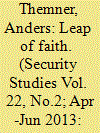

|
|
|
|
|
| Publication |
2013.
|
| Summary/Abstract |
Previous research has given scant attention to the issue of how and when ex-combatants resort to organized violence. This article fills this research gap by comparing ex-fighters in the Republic of Congo and Sierra Leone. It holds that ex-combatant violence is the result of interaction between entrepreneurs of violence, military affinities, intermediaries, and selective incentives. Ex-combatants take to arms when they have access to entrepreneurs of violence. By offering selective incentives and utilizing existing military affinities, entrepreneurs can generate the enticements and trust needed to convince ex-combatants to resort to arms. However, as entrepreneurs have limited contact with ex-fighters, they are dependent on intermediaries to do the actual recruiting for them. Contrary to previous assumptions, this article finds that ex-fighters are largely risk-averse individuals and that ex-combatant violence is seldom triggered by the mere presence of small arms, lack of economic opportunities, or experiences of insecurity.
|
|
|
|
|
|
|
|
|
|
|
|
|
|
|
|
| 5 |
ID:
121406


|
|
|
|
|
| Publication |
2013.
|
| Summary/Abstract |
The most striking aspect of the current scholarly debate over the political effectiveness of non-state violence is that, upon careful examination, there is not much of a debate to be found. Despite seemingly irreconcilable positions claiming that terrorism and insurgency "work" or "do not work," varying case selection and thresholds for success lie at the root of these debates, not disagreements over the empirical record. Although this previously unrecognized empirical consensus helps to resolve existing disputes, it relies on single-level strategic frameworks that fail to capture the effectiveness of violence from the perspective of those who employ it. This article presents an alternative concept of political effectiveness based on a two-level framework that accounts for the fact that insurgencies are not unitary actors, but are instead marked by armed groups that pursue strategic objectives that benefit their larger social movements (such as the overthrow of a regime or the withdrawal of enemy troops), while they simultaneously pursue organizational objectives that benefit the groups themselves (such as increasing membership or funding). Empirical analysis of eight paradigmatic campaigns common to studies of insurgency and terrorism across time and space reveals that the two-level framework better captures the political effectiveness of non-state violence than existing single-level models and primes the subfield for powerful new theories that explain greater variation in the use and effectiveness of non-state violence.
|
|
|
|
|
|
|
|
|
|
|
|
|
|
|
|
| 6 |
ID:
121404
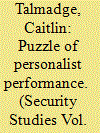

|
|
|
|
|
| Publication |
2013.
|
| Summary/Abstract |
Saddam's Iraq has become a cliché in the study of military effectiveness-the quintessentially coup-proofed, personalist dictatorship, unable to generate fighting power commensurate with its resources. But evidence from the later years of the Iran-Iraq War actually suggests that the Iraqi military could be quite effective on the battlefield. What explains this puzzling instance of effectiveness, which existing theories predict should not have occurred? Recently declassified documents and new histories of the war show that the Iraqi improvements stemmed from changes in Saddam's perceptions of the threat environment, which resulted in significant shifts in his policies with respect to promotions, training, command arrangements, and information management in the military. Threat perceptions and related changes in these practices also help explain Iraq's return to ineffectiveness after the war, as evident in 1991 and 2003. These findings, conceived as a theory development exercise, suggest that arguments linking regime type and coup-ridden civil-military relations to military performance need to take into account the threat perceptions that drive autocratic leaders' policies toward their militaries. After discussing how to define and measure battlefield effectiveness, the article reviews Saddam's changes and their effects; addresses alternative explanations for the improvement in Iraqi effectiveness; and explains how further research based on this initial exercise could generate a better understanding of the observed variation in states' battlefield effectiveness, including variation within and across autocratic regimes.
|
|
|
|
|
|
|
|
|
|
|
|
|
|
|
|
|
|
|
|
|